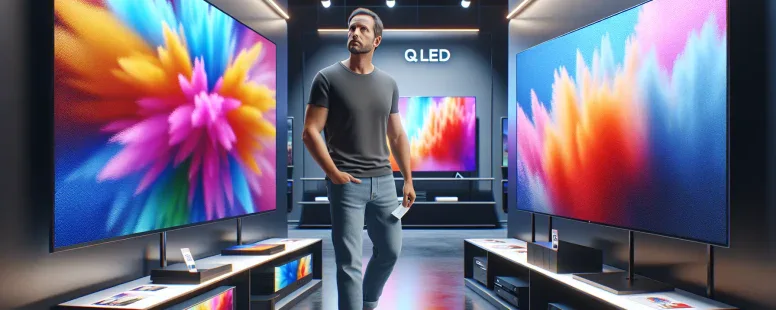Difference Between QLED and Mini LED: Which TV Technology is Right for You?
Picture this: you’re standing in an electronics store, surrounded by dazzling screens that promise the ultimate viewing experience. Words like “QLED” and “Mini LED” flash across labels, but what do they really mean? If you’ve ever felt torn between these two cutting-edge technologies, you’re not alone. Choosing the perfect TV can feel overwhelming when every option claims to be the best.
Understanding the difference between QLED and Mini LED isn’t just about decoding tech jargon—it’s about finding what fits your needs. Whether you’re after vibrant colors that pop or deeper contrast for cinematic immersion, each technology offers its unique strengths. By diving into their core features, you’ll discover which one aligns with how you watch and enjoy content.
Ready to unravel the mystery behind these glowing acronyms? Let’s explore how QLED and Mini LED stack up against each other so you can make a confident choice.
What Is QLED?
QLED, or Quantum Dot Light Emitting Diode, is a display technology that enhances color and brightness in TVs. It uses quantum dots to improve the picture quality by delivering vibrant colors and higher luminance.
Technology Overview
QLED integrates an LED backlight with a quantum dot layer. This layer contains nano-sized semiconductor particles that emit precise colors when exposed to light. These dots work alongside an LCD panel to produce images on the screen. Unlike OLED displays that generate their own light, QLED relies on external backlighting.
For example, in bright viewing environments like sunlit living rooms, QLED screens maintain visibility due to their high brightness levels. Samsung pioneered this technology in 2017 and remains a market leader.
Advantages Of QLED
- Brightness: The LED backlight enables intense brightness levels exceeding most other TV technologies.
- Color Accuracy: Quantum dots provide improved color accuracy and saturation across various content types.
- Durability: QLED panels resist burn-in issues often found in OLED displays, making them suitable for static images or gaming interfaces.
- Screen Size Options: Available from mid-range sizes (43″) up to ultra-large formats (98″), catering to diverse preferences.
These traits make QLED ideal for users prioritizing vivid visuals and broad usability in well-lit spaces.
Limitations Of QLED
- Limited Contrast Ratios: Since it depends on an LED backlight, achieving true blacks isn’t possible as some light bleeds through darker scenes.
- Viewing Angles: Image quality degrades when viewed from extreme angles compared to OLED screens.
- Energy Consumption: Higher brightness requires more power than energy-efficient alternatives like Mini LEDs or OLEDs.
While excelling in specific scenarios like brightly lit rooms or large screen applications, these drawbacks affect performance under conditions demanding deeper contrast or wider viewing flexibility.
What Is Mini LED?
Mini LED is a backlighting technology that uses an array of thousands of tiny light-emitting diodes to illuminate the display panel. These LEDs are much smaller than those in traditional LED TVs, allowing for more precise control over brightness and contrast.
Technology Overview
Mini LED consists of many densely packed microscopic LEDs behind the LCD screen. Each diode can be dimmed or brightened individually or in groups, creating local dimming zones. This structure enhances black levels and reduces halo effects around bright objects on dark backgrounds. Manufacturers like TCL, Samsung, and LG use Mini LEDs to create displays with higher dynamic range compared to standard LEDs.
Advantages Of Mini LED
- Enhanced Contrast: Mini LEDs deliver deeper blacks by minimizing light leakage.
- Improved Brightness: Displays achieve higher peak brightness levels suited for HDR content.
- Reduced Halo Effect: Smaller diodes enable better control over blooming artifacts.
- Affordable Alternative: Compared to OLEDs, Mini LED offers similar performance at lower costs.
For instance, if you’re watching a movie with starry skies in a dark scene, you’ll notice sharper distinctions between stars and the black background due to reduced blooming.
Limitations Of Mini LED
- Limited Viewing Angles: Picture quality degrades when viewed from extreme angles since it’s still based on LCD panels.
- Higher Cost Than Standard LEDs: Although cheaper than OLEDs, it remains pricier than conventional LCD TVs.
- Complex Manufacturing Process: Integrating thousands of tiny diodes can lead to increased production challenges.
While offering significant improvements over standard technologies, these limitations mean that choosing Mini LED often depends on your budget and viewing priorities.
Key Differences Between QLED And Mini LED
Understanding the differences between QLED and Mini LED helps you evaluate which technology meets your viewing preferences. Each offers unique strengths based on display design, picture quality, brightness, energy use, and cost.
Display Technology
QLED uses an LED backlight paired with a quantum dot layer to enhance colors and brightness. Quantum dots emit specific light wavelengths when illuminated by the backlight, resulting in vibrant color reproduction. The technology relies on edge-lit or full-array LED systems for illumination.
Mini LED employs thousands of microscopic LEDs as a backlighting system. These LEDs are smaller than those in traditional displays, allowing for precise dimming zones. This precision enables better control over light distribution across the screen.
Picture Quality
QLED produces vivid colors with high saturation levels due to its quantum dot layer but has limitations in achieving deep blacks. The reliance on an external backlight can lead to haloing around bright objects against dark backgrounds.
Mini LED excels with superior contrast ratios and reduced halo effects thanks to localized dimming zones. It achieves deeper blacks by turning off specific LEDs in darker scenes while maintaining detail in brighter areas.
Brightness And Contrast
QLED delivers exceptional brightness levels suited for well-lit environments or rooms with direct sunlight exposure. Brightness is a strong point of this technology because of its enhanced luminance capabilities driven by quantum dots.
Mini LED balances both brightness and contrast effectively through advanced dimming techniques. It handles HDR content more accurately by offering higher peak brightness alongside rich black levels without compromising details.
Energy Efficiency
QLED consumes relatively more power due to its high-brightness output supported by powerful backlights. The energy demand increases further when operating at maximum luminance settings for extended periods.
Mini LED’s efficient diode arrangement reduces overall energy consumption compared to QLEDs while still providing excellent brightness performance. Its targeted lighting approach minimizes unnecessary electricity usage during operation.
Cost And Availability
QLED TVs are widely available across various price ranges from mid-tier models like Samsung’s Q60 series to premium ones such as the QN90 lineup. Pricing depends on screen size, resolution (4K/8K), and additional features like smart TV integration.
Mini LEDs generally cost more than standard QLEDs because of their complex manufacturing process involving miniaturized components and advanced circuitry design. But, they’re increasingly becoming accessible through brands like TCL or LG offering competitive options under $2,000 for select 65-inch models.
Which Option Is Right For You?
Choosing between QLED and Mini LED depends on your viewing environment, content preferences, and budget. QLED suits bright rooms where vibrant colors and high luminance enhance the experience. Sports enthusiasts or those who watch daytime TV may find QLED’s brightness ideal.
Mini LED works better in dimly lit spaces because of its superior contrast and deeper blacks. If you enjoy movies or HDR gaming, Mini LED offers an immersive experience with reduced halo effects. It also consumes less energy, making it a practical choice for eco-conscious viewers.
Budget considerations play a significant role. QLED TVs offer options at various price points, from entry-level to premium models. Mini LEDs typically cost more due to advanced technology but provide value through enhanced performance for discerning users.
Consider screen size when deciding—QLED provides a wider range of sizes suitable for diverse room layouts. But, if picture quality is your top priority over size flexibility, Mini LED delivers exceptional results in smaller to mid-sized displays.
Ask yourself: Is vivid brightness more important than deep contrast? Do you prioritize affordability over cutting-edge technology? Aligning these factors with your needs narrows down the best option without confusion.
Conclusion
Choosing between QLED and Mini LED comes down to what matters most to you. Whether it’s vibrant colors in a bright room or deeper contrast for immersive movie nights, understanding these technologies helps you pick the right TV for your needs. Consider your viewing habits, environment, and budget carefully to ensure you’re investing in a display that enhances your experience. Both options offer impressive features, so aligning them with your preferences is key to making the perfect choice.
- Understanding the Difference Between Oath and Affirmation: Key Facts You Need to Know - October 30, 2025
- Understanding the Difference Between Annulled and Divorced: Key Legal and Emotional Insights - October 30, 2025
- Ibuprofen vs. Aspirin: A Comprehensive Comparison - October 30, 2025






